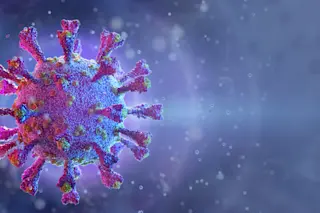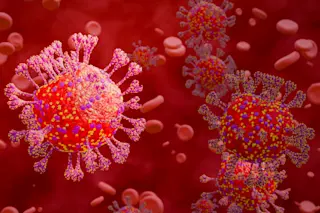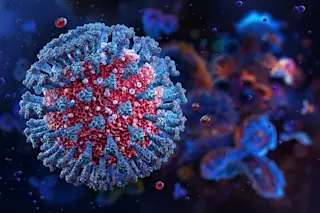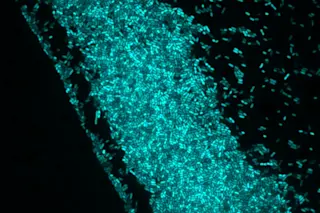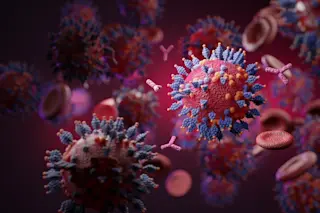Sex, blood, and death have been the stuff of myth and superstition for thousands of years. Is it any wonder, then, that a lethal disease as little understood as AIDS should be the stuff of twentieth- century mythmaking? AIDS came to light only 14 years ago as a strange disease in gay men. Within a year it had become clear that the illness was being transmitted not only through sex but through blood as well. Today AIDS is the leading cause of death in young American men. In parts of sub- Saharan Africa, it kills both men and women in shocking numbers--it causes 80 percent of young adult deaths in southwest Uganda, for example. Meanwhile the responsible retrovirus, HIV, continues to spread ruthlessly through South America and Asia. A tragedy on this scale is almost bound to attract explanations that ascribe blame to others while betraying the obsessions of their purveyors.
As Susan Sontag pointed out in her perceptive essay AIDS and Its Metaphors, this disease has become the scourge of our day. AIDS has supplanted cancer as the unclean disease, the one associated with guilt, anger, helplessness, and hopelessness. Since AIDS has an average incubation period of about nine years, the stigmatization of the disease affects even the "future ill": quite healthy HIV-positive people are denied life insurance and shunned as harbingers of death, or infectious lepers in our midst. Unlike cancer patients of a generation ago, however, people with AIDS have taken an active part in affirming their rights, seeking information, and promoting the search for a cure. While some of these advocacy groups work with doctors and scientists, others view the "AIDS establishment" with deep mistrust, accusing researchers of making their career in AIDS solely because it's a source of money and kudos.
All this is fertile ground for the creation of myths. They fall into two main categories, myths of blame and myths of denial. Some people, for example, desperately want to find a scapegoat for AIDS, someone to hold responsible for unleashing this new, unstoppable plague. Hence the allure of the notion that science played a role in its origin, whether by design or by a disastrous and subsequently covered-up mistake. One conspiracy theory has it that HIV is man-made, a hybrid engineered from two other retroviruses, the human T-cell leukemia virus (HTLV) and the maedi-visna virus of sheep. Scientifically, we've known this is nonsense ever since the genes of HIV were sequenced in 1985. None of the genetic sequences of HIV match those of HTLV or the sheep virus. But the theory survives by dint of arguing that HIV is so genetically variable that it could quickly have evolved away from its parent viruses.
American conservatives were the first to hypothesize that HIV was a "designer virus," made by the Soviets for germ warfare. (The Soviets meanwhile labeled AIDS a disease of the decadent West.) Even today the theory of a genetically manipulated hybrid human-sheep virus persists in Africa, with the villain being the United States. Some African Americans also believe HIV was constructed and unleashed on them as a form of genocide. An accusatory finger has been pointed at the Frederick Cancer Research and Development Center in Maryland, now part of the National Institutes of Health. During the cold war, this place was the site of the U.S. Army's Fort Detrick chemical and biological defense facility. One conspiracy theory holds that HIV was constructed there in the 1960s as a biological weapon (though it's of little use since it takes years to cause disease). Allegedly, HIV was tested on volunteers in U.S. prisons, then became uncontrollable as prisoners unwittingly spread it by injecting drugs or having anal sex. This heady stuff has all the ingredients of a good sci- fi yarn, combining the construction of a new germ by scientists in the pay of the military with a microbe escaping through forbidden--and covert-- social behavior.
But this fanciful scenario breaks down under the weight of a couple of awkward facts. First, as already mentioned, the virus doesn't resemble either of the viruses from which it's supposedly created. Rather it resembles simian--ape and monkey--viruses that occur naturally in the wild. Second, the timing is wrong: one can now date the earliest human infections at least as far back as the late 1950s, long before techniques for gene cloning and recombination had even been thought of. Nevertheless, variants of the man-made virus theory continue to hold sway. Many Africans detest the notion that HIV came "out of Africa"--it is bad enough to bear the brunt of the AIDS epidemic without being blamed for its origin.
Another popular theory has it that the virus was an unfortunate side effect of polio vaccine testing. This story implies more a foul-up than a conspiracy, with the familiar theme of science going horribly wrong. The idea gained wide credence through a 1992 Rolling Stone article titled "The Origin of AIDS: A Startling New Theory Attempts to Answer the Question Was It an Act of God or an Act of Man?" According to the article, Blaine Elswood, a San Francisco AIDS activist, had unearthed evidence that AIDS arose from monkey cells used in polio vaccine research. In fact, the theory was hardly new. I first read about it in 1987 in a tract put out by the National AntiVivisection Society, a British animal-rights advocacy group.
Could a vaccine preparation indeed have been the original source of contamination? The polio vaccine consists of live but deliberately weakened polioviruses that are grown in primate cells--cells derived from monkeys' kidneys, to be precise. Suppose those monkeys harbored SIV, the simian version of the immunodeficiency virus? Surely, the theory argues, this could have been the origin of human AIDS. SIV could have been sprayed into volunteers' mouths when oral polio vaccines were being tested and could have evolved inside its human hosts to become HIV.
The details are more complex, however. In the wild, SIV is restricted to African species, and the monkeys routinely used for making polio vaccines were Asian macaques. But according to Rolling Stone's article, there was one exception: in the haste to develop polio vaccines, Hilary Koprowski, now at Thomas Jefferson University in Philadelphia, used cells from African green monkeys to propagate a poliovirus for a vaccine trial on the Burundi-Zaire border--close to where some researchers think AIDS arose.
Even if the article got its facts straight--which Koprowski adamantly denies--the theory looks highly implausible. First, there's the chronology of events. The field trials in central Africa were carried out in 1957 and 1958, yet the first confirmed AIDS case was retrospectively diagnosed in a British seaman who became ill and died of AIDS in 1959. Now, a sailor is just the sort of person to be a disseminator of a future epidemic. Yet there's no record of this seaman sailing to Africa. And if he picked up the virus from someone vaccinated in 1957 or 1958, he must hold a record for progressing from infection to AIDS.
Second, it is important to realize that there are actually two distinct kinds of human AIDS virus. The worldwide pandemic is caused by HIV-1, the type found in central Africa. This virus, however, is not so closely related to the monkey virus, SIV, that allegedly contaminated Koprowski's polio vaccines. On the other hand, SIV--especially SIV isolated from another African monkey, called the sooty mangabey--is closely related to the second AIDS virus, HIV-2. The snag (for the conspiracy theorist) is that mangabeys were never used for polio vaccine preparations. Furthermore, this virus was until recently restricted to people in West Africa, mainly in Guinea-Bissau, some 3,000 miles from the scene of Koprowski's vaccine trials. All in all, the timing, geography, and type of HIV just don't seem to fit together to incriminate Koprowski's vaccine.
Having said that, I do think it's highly probable that humans were originally infected by animal viruses. HIV-2 is too close to the SIV of sooty mangabeys to be a coincidence, and the original focus of HIV-2 infection in West Africa is located where mangabeys live and are occasionally killed and eaten. Indeed, Beatrice Hahn of the University of Alabama Medical Center in Birmingham has shown that healthy humans in West Africa can harbor infections with apparently less virulent strains of immunodeficiency virus that are closer to the simian strains than to the ones that cause AIDS. As for HIV-1, a virus very much like it has been isolated from two chimpanzees in Gabon and Cameroon in central Africa. Whether these apes naturally harbored the virus or whether they acquired it from humans remains a moot point. But if chimpanzees really are a natural reservoir of an HIV-1 lookalike, then they're very possibly the source of human AIDS.
This transmission of disease from animals to humans is called zoonosis. In the case of HIV, what most probably began as an extremely rare zoonosis established itself as a human-to-human infection. Less clear is just how long ago the SIV precursors of HIV were introduced into humans, though studies of the viruses' gene sequences and the degree to which they've diverged suggest the transfer occurred within the last 50 years.
Many scientists declare that pursuing HIV's origins is a waste of time in the face of the immense problem of combating a human pandemic. I disagree. There may be important lessons to be learned to prevent future pestilences. While the polio vaccine theory looks implausible, I do think the risks of iatrogenic transmission--inadvertently spreading the virus through medical practice--are genuine. We know HIV was spread through blood transfusion in Western countries, and through nonsterile injections in Eastern Europe and Africa. So an iatrogenic origin of human infection remains quite conceivable. In fact, according to Charles Gilks, a British tropical disease specialist, there was some early malaria research in which blood from chimps, mangabeys, and macaques was inoculated into human volunteers. Injecting people with ape and monkey blood--provided it was also infected with immunodeficiency viruses--would be far more likely than a polio vaccine to cause these viruses to adapt into HIV-1 and HIV-2.
We live in litigious times, and Koprowski's initial reaction to the Rolling Stone piece was to sue for libel rather than to offer a closely reasoned, scientifically argued response to a purported theory. (Such a reply was eventually published in Science, a journal more suitable to eponymous discussion than a fanzine. Among other things, Koprowski pointed out that he'd done his polio vaccine work in cells from SIV-free Asian macaques, just like everyone else, and not from African green monkeys.) Unfortunately, to some untutored minds, the theory has since been transmuted into the notion that present-day polio vaccines are spreading AIDS. In Illinois the father of a girl who is inexplicably infected with HIV-1 is now suing the drug company that provided her polio vaccine. We seem to have come full circle from the grateful society of 30 years ago that lauded Jonas Salk and Albert Sabin, whose vaccines saved our children from crippling disease and death. The danger now is that a public frightened by an unlikely theory told as a really good yarn might withhold their children from life-saving immunizations.
When faced with an insoluble problem, it is tempting to deny that it exists. Zaire, perhaps the most severely affected country, reported no AIDS cases to the World Health Organization before 1986. In Western countries--where the spread of AIDS among heterosexuals lags behind the epidemic seen among gay men and drug abusers--it is no doubt comforting to delude oneself that AIDS is confined to these groups. But of all the myths surrounding AIDS, surely the most absurd is the proposition that HIV does not cause it. Extraordinarily, this belief has had powerful support from eminent scientists, notably Peter Duesberg, a molecular biologist at the University of California at Berkeley, and more recently Kary Mullis, last year's Nobel laureate for chemistry. How seductive this idea must be to a person who is HIV-positive but not yet ill! And what a wonderful opportunity for bashing science when one or two pundits declare that the rest of us are rushing headlong in the wrong direction, like the Gadarene swine. This denial theory took curious hold in the British media, especially in the once respected Sunday Times.
Duesberg's arguments have always struck me as antiquated; they're based on a narrow view of Robert Koch's postulates, published over 100 years ago. Koch, a bacteriologist, stipulated that (1) the causative agent occurs in each case of disease; (2) it is not found in other diseases or in healthy people; and (3) after isolation in pure form, it can induce the disease anew--in test animals, for example. Koch soon abandoned his second postulate on discovering asymptomatic disease carriers like "Typhoid Mary." And he never could satisfy the third postulate for the greatest of his own scientific discoveries, the tuberculosis bacterium. We, on the other hand, do have an animal model for HIV in SIV--pure, cloned forms of the virus reliably induce AIDS in monkeys.
Duesberg has argued that HIV cannot cause AIDS because there appear to be insufficient titers of virus in the blood, ignoring the fact that the virus chiefly resides and multiplies in the lymphoid organs. He has further said that since people respond to infection by making HIV antibodies, which must surely be protective, HIV can't be the problem-- forgetting there are some viral infections (like dengue) in which antibodies don't ward off disease and can even make it worse. Furthermore, Duesberg has stated that all other disease-causing microbes either induce illness acutely or not at all. This extraordinary error ignores hepatitis, cervical cancer, shingles, and other chronic or delayed viral diseases that can take much of a lifetime to become manifest.
Because HIV fits AIDS so well, Duesberg stretched his denial to form a more general hypothesis--namely, that AIDS is not an infectious disease at all. AIDS, he said, is caused by drugs, whether recreational drugs like poppers, or medical drugs, such as AZT, taken for the very purpose of blocking HIV. Yet the arguments for a transmissible, infectious agent causing AIDS were compelling even before HIV was discovered. Within months of identifying AIDS as a new type of immunodeficiency in 1981, the Centers for Disease Control in Atlanta showed that people who received blood from donors with AIDS were themselves at high risk for the disease. It also became clear that the virus could be sexually transmitted not only among gays but from bisexuals to women and from hemophiliac men to their wives.
After HIV was isolated in 1983 and antibody tests were devised in 1984 to spot infection, the data began to pour in. Two main types of evidence make HIV guilty of AIDS, from what epidemiologists call cross- sectional and longitudinal studies. The cross-sectional evidence came from surveys of people with different degrees of risk. The greater the risk of AIDS, the higher the proportion of individuals with HIV infection. Thus HIV was prevalent in the larger gay communities, among hemophiliacs who received clotting factors pooled from thousands of donors, and among injecting drug users. Moreover, when people outside a known risk group developed AIDS, they were overwhelmingly--99.5 percent of them--found to be HIV-positive. Geographically, too, HIV is associated with AIDS wherever one looks--in gay men in San Francisco, injecting drug addicts in Edinburgh, hemophiliacs in Tokyo, prostitutes in Nairobi, orphans in Bucharest, soldiers in Bangkok. No other common factor exists between such diverse individuals.
Still, it was argued, the common presence of HIV among those at greatest risk for AIDS was merely association, not proof of causality. That is where longitudinal evidence came in. For example, in a study set up in 1978, blood was taken year after year from hundreds of gay men in San Francisco and stored for the original purpose of tracking hepatitis B. Analysis of these samples over an eight-year period showed how HIV began to infect the most promiscuous men in the late 1970s and spread from them to others. Furthermore, only those individuals who became infected with HIV later developed AIDS. Much the same story emerged from other, "cohort" studies. Among infants born to HIV-positive women, only about one in four acquires its mother's HIV, and it's only that baby who succumbs to AIDS. Most compelling is that not a single HIV-negative hemophiliac is known to have died from symptoms resembling AIDS, yet the toll on those infected by HIV has been terrible.
To argue around this huge weight of evidence, denial has to beget denial. Last year, not content to decry the causal role of HIV, the British Sunday Times declared there is no AIDS in Africa. Now, it's perfectly true that people with AIDS are open to severe infections by other germs. Often these infections (for example, Pneumocystis pneumonia) are opportunistic, in the sense that they almost never fell people with healthy immune systems, while others, like TB, can cause disease in their own right but tend to be more severe in AIDS patients. The naysayers, however, claim that "AIDS" is just TB or Kaposi's sarcoma that's renamed if someone happens to test HIV-positive. There's an element of reason to this argument, as the occurrence of these illnesses in members of AIDS risk groups is likely to lead to their classification as AIDS. For example, the Centers for Disease Control used to define the syndrome purely by its symptoms and opportunistic infections. Then last year that definition was updated to include testing positive for HIV--thus, claim the naysayers, linking the virus to the disease became a self-fulfilling prophecy.
Again, attention to detail dispels the doubt about AIDS in Africa. True, Kaposi's sarcoma existed there long before AIDS, but the endemic disease seldom spread beyond people's lower limbs. Nine years ago, however, it became clear to Anne Bayley, a cancer specialist in Zambia, that Kaposi's in Africans with HIV was a body-wide disease, just like that in gay Americans. The story with tuberculosis is the same. Of course, TB kills in the absence of HIV, but it is much more destructive in the immunodeficient individual. A longitudinal study in The Lancet this year helped put the matter to rest. Over a two-year period, HIV-positive young men and women in Uganda were 60 times more likely to die than their carefully matched HIV-negative counterparts. That is a stronger causal association than the one between cigarette smoking and lung cancer.
Regrettably, it is often the popular media rather than dry, stuffy reports that sway the political process. Denial myths promulgated by respectable newspapers may be seized on, not only by hapless individuals but also by governments lacking the financial resources or resolve to implement what few means of AIDS prevention we have at our disposal. When all logic fails, the nihilists blame the messengers. The Sunday Times thunders self-righteously that AIDS researchers like me are on the make, greedily devouring government handouts, or are beholden to the pharmaceutical industry, which itself profits from selling poisonous drugs. Meanwhile the same propagandists who attack mainstream science dote on the words of one or two dissident scientists talking outside their own fields. One recalls the late physicist William Shockley, winner of a Nobel Prize for inventing the transistor, who went on to pontificate on the "intellectual superiority" of whites over blacks.
Yet we scientists need to learn a little humility, too. We may be certain that HIV causes AIDS, but we understand little about how it does so or where it came from, and even less about how to prevent it. As long as this is so, myths will continue to rise from the miasma.






